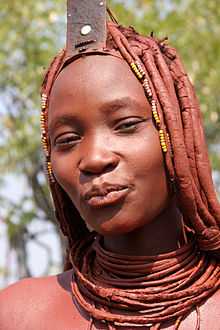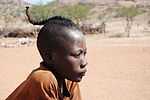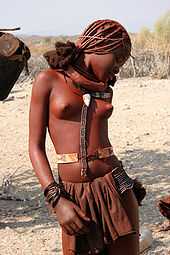Himba people

The Himba (singular: Omuhimba, plural: Ovahimba) are indigenous peoples of about 20,000 to 50,000 people[1] living in northern Namibia, in the Kunene region (formerly Kaokoland) and on the other side of the Kunene River in Angola. There are also few groups left of the Ovatwa, which also belong to the Himba people, but are hunters and gatherers. Himba are mostly a semi-nomadic, pastoral people, closely related to the Herero, and speak Otjihimba, that is similar to the Herero language.
Culture
Daily life

The Himba breed cattle and goats. The responsibility for milking the cows lies with the women. Women take care of the children, and one woman will take care of another woman's children. Women tend to perform more labor-intensive work than men do, such as carrying water to the village and building homes. Men handle the political tasks and legal trials.[citation needed]Men also care for, herd, and slaughter the cattle for special occasions.
Members of an extended family typically dwell in a homestead, "a small, circular hamlet of huts and work shelters" that surrounds "an okuruwo (ancestral fire) and a central livestock enclosure." Both the fire and the livestock are closely tied to their belief in ancestor worship, the fire representing ancestral protection and the livestock allowing "proper relations between human and ancestor."[2] The breasts are nonsexual, but the buttocks are always carefully covered.
Both boys and girls are circumcised before puberty, to make them eligible for marriage.[3]
Clothing and hair style


The Himba wear little clothing, but the women are famous for covering themselves with otjize, a mixture of butter fat and ochre,[4] possibly to protect themselves from the sun.[5] The mixture gives their skins a reddish tinge. This symbolizes earth's rich red color and the blood that symbolizes life, and is consistent with the Himba ideal of beauty.[5] Women braid each other's hair and cover it except the ends, in their ochre mixture.
Modern clothes are scarce, but generally go to the men when available.[citation needed] Traditionally both men and women go topless and wear skirts or loincloths made of animal skins in various colors. Adult women wear beaded anklets to protect their legs from venomous animal bites.[citation needed]
The hairstyle of the OvaHimba indicates age and social status. Children have two plaits of braided hair. From the onset of puberty the girls' plaits are moved to the face over their eyes, and they can have more than two. Married women wear headdresses with many streams of braided hair, coloured and put in shape with otjize. Single men wear one plait backwards to their necks, while married men wear a turban of many otjize-soaked plaits[3][6][7]
Tribal structure

Because of the harsh desert climate in the region where they live and their seclusion from outside influences, the Himba have managed to maintain much of their traditional lifestyle. Members live under a tribal structure based on bilateral descent that helps them live in one of the most extreme environments on earth.
Under bilateral descent, every tribe member belongs to two clans: one through the father (a patriclan, called oruzo) and another through the mother (a matriclan, called eanda).[8] Himba clans are led by the eldest male in the clan. Sons live with their father's clan, and when daughters marry, they go to live with the clan of their husband. However, inheritance of wealth does not follow the patriclan but is determined by the matriclan, that is, a son does not inherit his father's cattle but his maternal uncle's instead.

Bilateral descent is found among only a few groups in West Africa, India, Australia, Melanesia and Polynesia, and anthropologists consider the system advantageous for groups that live in extreme environments because it allows individuals to rely on two sets of families dispersed over a wide area.[9]
History
The Himba's history is fraught with disasters, including severe droughts and guerrilla warfare, especially during Namibia's quest for independence and as a result of the civil war in neighboring Angola. In 1904, they suffered from the same attempt at genocide by the German colonial power under Lothar von Trotha that decimated other groups in Namibia, notably the Herero and the Nama.[citation needed]
In the 1980s it appeared the Himba way of life was coming to a close. A severe drought killed 90% of their cattle, and many gave up their herds and became refugees in the town of Opuwo living in slums on international relief. Because they live on the Angolan border, many Himba were also kidnapping victims in the Angolan civil war.[citation needed]
Religion
The Himba are a monotheistic people who worship the god Mukuru, as well as their clan's ancestors. Mukuru only blesses, while the ancestors can bless and curse.[10] Each family has its own ancestral fire, which is kept by the fire-keeper. The fire-keeper approaches the ancestral fire every seven to eight days in order to communicate with Mukuru and the ancestors on behalf of his family.[11] Often, because Mukuru is busy in a distant realm, the ancestors act as Mukuru's representatives.[11]
The Himba traditionally believe in omiti, which some translate to mean witchcraft but which others call "bad medicine".[12] Some Himba believe that death is caused by omiti, or rather, by someone using omiti for malicious purposes.[13] Additionally, some believe that evil people who use omiti have the power to place bad thoughts into another's mind[14] or cause extraordinary events to happen (such as when a common illness becomes life-threatening).[15] But users of omiti do not always attack their victim directly; sometimes they target a relative or loved one.[16] Some Himba will consult a diviner to reveal the reason behind an extraordinary event, or the source of the omiti.[15]
Since Namibian independence

The Himba have been successful in maintaining their culture and traditional way of life.
Even so the Himba have worked with international activists to block a proposed hydroelectric dam along the Kunene River that would have flooded their ancestral lands,[17] 2011, Namibia announced its new plan to build a dam in Orokawe, in the Baynes Mountains. The Himba submitted in February 2012 their protest Declaration against the hydroelectric dam to the United Nations, the African Union and to the Government of Namibia.[18]
The government of Norway and Iceland funded mobile schools for Himba children, but since Namibia took them over in 2010, they have been converted to permanent schools and are no longer mobile. The Himba leaders complain in their declaration about the culturally inappropriate school system, that they say would threaten their culture, identity and way of life as a people.
Human rights
Groups of the last remaining hunters and gatherers Ovatwa are held in secured camps in the northern part of Namibia's Kunene region, despite complaints by the traditional Himba chiefs that the Ovatwa are held there without their consent and against their wishes.[19]
In February 2012, traditional Himba chiefs[20] issued two separate Declarations[21][22] to the African Union and to the OHCHR of the United Nations.
The first, titled "Declaration of the most affected Ovahimba, Ovatwa, Ovatjimba and Ovazemba against the Orokawe Dam in the Baynes Mountains"[18] outlines the objections from regional Himba chiefs and communities that reside near the Kunene River.
The second, titled "Declaration by the traditional Himba leaders of Kaokoland in Namibia"[21] lists violations of civil, cultural, economic, environmental, social and political rights perpetrated by the government of Namibia (GoN).
September 2012, the United Nations Special Rapporteur on the Rights of Indigenous Peoples visited the Himba and heard their concerns that they do not have recognized traditional authorities and that they are placed under the jurisdictions of chiefs of neighboring dominant tribes, who make decisions on behalf of the minority communities. In his view, the lack of recognition of traditional chiefs, in accordance with Namibian law, relates to a lack of recognition of the minority indigenous tribes' communal lands.[23]
November 23, 2012, hundreds of Himba and Zemba from Omuhonga and Epupa region protested in Okanguati against Namibia's plans to construct a dam in the Kunene River in the Baynes Mountains, against increasing mining operations on their traditional land and human rights violations against them.[24]
March 25, 2013, over 1,000 Himba people marched in protest again, this time in Opuwo, against the ongoing human rights violations that they endure in Namibia. They expressed their frustration over the lack of recognition of their traditional chiefs as "Traditional Authorities" by the government;[24] Namibia's plans to built the Orokawe dam in the Baynes Mountains at the Kunene River without consulting with the Himba, who do not consent to the construction plans; culturally inappropriate education; the illegal fencing of parts of their traditional land; and their lack of property rights to the territory that they have lived upon for centuries. They also protested against the implementation of the Communal Land Reform Act of 2002.[25]
On October 14, 2013, Himba chief Kaipka, on behalf of his region Epupa and the community which was featured in German RTL reality TV show Wild Girls condemned the misuse of Himba people, individuals and villagers in the show, and demanded the halt of broadcasting any further episodes as they would mock the culture and way of being of the Himba people.[26]
Anthropological investigations
Color perception
Several researchers have studied the Himba perception of colours.[27] The Himba use four colour names: zuzu stands for dark shades of blue, red, green and purple; vapa is white and some shades of yellow; buru is some shades of green and blue; and dambu is some other shades of green, red and brown. It is thought that this may increase the time it takes for the Himba to distinguish between two colours that fall under the same Herero colour category, compared to people whose language separates the colours into two different colour categories.[28]
Gallery
-

Himba village about 15 km north of Opuwo, Namibia.
-
Himba woman and some of her family standing in her father's homestead in Otutati, Namibia.
-
.jpg)
Himba woman (Namibia, Southern Africa)
-

Himba teenager, north of Opuwo, Namibia
-

Himba woman
-

Himba hut
-

As is customary in her culture, a bare-breasted Himba woman of northern Namibia wears a traditional headdress and skirt.
References
- ↑ Lange, Karen E. (January 2004). "Himba: Consulting the past, Divining the future". National Geographic.
- ↑ Crandall 2000, p. 18.
- ↑ 3.0 3.1 Popovic, Mislav. "Himba people". Traditions Customs. Retrieved 2012-08-04.
- ↑ Crandall 2000, p. 48.
- ↑ 5.0 5.1 Olfami, Kuni. "African Tribes: Indigenous People of Africa". African Tribes. Retrieved 2012-08-04.
- ↑ Kcurly (4 January 2011). "Himba Hair Styling". Newly Natural. Retrieved 2012-08-04.
- ↑ "Tribes of Africa. The Himba". Africa Travel. About.com. Retrieved 2012-08-04.
- ↑ Crandall 2000.
- ↑ Ezzell, Carol (17 June 2001). "The Himba and the Dam". Scientific American. (subscription required (help)).
- ↑ Crandall 2000, p. 188.
- ↑ 11.0 11.1 Crandall 2000, p. 47.
- ↑ Crandall 2000, p. 33.
- ↑ Crandall 2000, pp. 38–39.
- ↑ Crandall 2000, p. 102.
- ↑ 15.0 15.1 Crandall 2000, p. 66.
- ↑ Crandall 2000, p. 67.
- ↑ "Namibia: Dam will mean our destruction, warn Himba". IRIN (United Nations Office for the Coordination of Humanitarian Affairs). 18 January 2008.
- ↑ 18.0 18.1 "Declaration of the most affected Ovahimba, Ovatwa, Ovatjimba and Ovazemba against the Orokawe Dam in the Baynes Mountains". Earth Peoples. 7 February 2012. Retrieved 2012-04-06.
- ↑ Cupido, Delme (28 February 2012). "Indigenous coalition opposed to new dam". OSISA. Retrieved 2012-02-28.
- ↑ "Indigenous Himba Appeal to UN to Fight Namibian Dam". Galdu. Agence France-Presse. Retrieved 2012-04-06.
- ↑ 21.0 21.1 "Declaration by the traditional Himba leaders of Kaokoland in Namibia". Earth Peoples. 20 January 2012. Retrieved 2012-04-06.
- ↑ "Namibian Minority Groups Demand Their Rights". Newsodrome. Retrieved 2012-04-06.
- ↑ "Statement of the Special Rapporteur on the rights of indigenous peoples, James Anaya, upon concluding his visit to Namibia from 20-28 September 2012". OHCHR. 28 September 2012. Retrieved 2012-11-28.
- ↑ 24.0 24.1 Sommer, Rebecca (23 November 2012). "Namibia: Indigenous semi-nomadic Himba and Zemba march in protest against dam, mining and human rights violations". Earth Peoples. Retrieved 2012-11-24.
- ↑ Sasman, Catherine. "Himba, Zemba reiterate 'no' to Baynes dam". The Namibian. Retrieved 2013-03-26.
- ↑ "Indigenous peoples Himba community condemn RTL TV series Wild Girls, asking Earth Peoples co-founder Rebecca Sommer for help to intervene on their behalf and stop it". Earth Peoples. Retrieved 2013-10-16.
- ↑ Roberson, Debi; Davidoff, Jules; Davies, Ian R.L.; Shapiro, Laura R. "Colour Categories and Category Acquisition in Himba and English" (pdf). The Department of Psychology. University of Essex. Retrieved 2012-05-28.
- ↑ Reiger, Terry; Kay, Paul (28 August 2009). "Language, thought, and color: Whorf was half right" (pdf). Trends in Cognitive Science. doi:10.1016/j.tics.2009.07.001. Retrieved 2012-08-29.
Further reading
- Crandall, David P. (2000). The Place of Stunted Ironwood Trees: A Year in the Lives of the Cattle-Herding Himba of Namibia. New York: Continuum International Publishing Group Inc. pp. 18, 33, 38–39, 47, 48, 66, 67, 102, 188. ISBN 0-8264-1270-X.
- Peter Pickford, Beverly Pickford, Margaret Jacobsohn: Himba; ed. New Holland Publishers (UK) Ltd, 1990; ISBN 978-1-85368-084-7
- Klaus G. Förg, Gerhard Burkl: Himba. Namibias ockerrotes Volk; Rosenheim: Rosenheimer Verlagshaus, 2004; ISBN 3-475-53572-6 (in German)
- Rina Sherman: Ma vie avec les Ovahimba; Paris: Hugo et Cie, 2009; ISBN 978-2-7556-0261-6 (in French)
External links
| Find more about Himba at Wikipedia's sister projects | |
| |
Definitions and translations from Wiktionary |
| |
Media from Commons |
| |
Quotations from Wikiquote |
| |
Source texts from Wikisource |
| |
Textbooks from Wikibooks |
| |
Learning resources from Wikiversity |
- HImbas, struggle for survive. Documentary project by galician photojournalist and filmmaker Delmi Alvarez (In progress)
- The Ovahimba Years I Les années Ovahimba
- Keep the Dance Alive I Que la danse continue
- Keep the Dance Alive on Flickr
- Sept années chez les Ovahimba
- Photographs of the Himba in Namibia
- A Peace Corps volunteer works among the Himba
- HIMBA CUSTOMS from Namibia. Extract from Last Free Men by José Manuel Novoa
- HIMBA DANCE in Omuhonga, Kaokoland, Namibia, video by Rebecca Sommer
Photographs
- Photos from Himba village near Opuwo, Namibia – Photographs and information.
- Africa on the Matrix: Himba People of Namibia – Photographs and information.
- Snapshots with the Himba people – Photography by Brent Stirton.
- Photos of the Himba People in Okangwati – Photography by Photographer Benjamin Rennicke.
